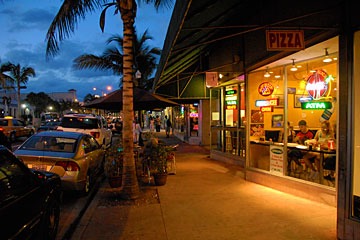search the Original Green Blog

On-street parking is important to good urbanism on many counts. Let's have a look at some of the most important reasons why it's essential:
Commercial Parking Lots

Would you be caught dead on this sidewalk?
If people can't park on-street, then off-street parking lots are essential in all but the most highly walkable places where cars are unnecessary (think Manhattan.) Surface parking lots do lots of damage. First, if they are built in front of a building, then they pretty much guarantee that nobody will ever walk on the sidewalk that runs between the parking lot and the street. Pedestrians aren't stupid… you'd be taking your life in your own hands by walking in a place like this because you have no protection from cars zipping by just a few feet away from you.
The second-worst place for a parking lot is beside the building because this creates a big gap in the urbanism. This condition is known as a "snaggletooth streetscape." One of its worst features is that it interrupts the continuity of the street face, making the place seem incomplete, or decaying. Another really bad feature is the fact that it bores the pedestrians, because when they're walking beside it, they get a steady view of cars that doesn't change very quickly. Unlike a parking lot in front, which completely kills pedestrianism in only one block, parking lots beside buildings only injure it, and the extent of the injury to walkability depends on how big the gaps between buildings are.
The third place for a parking lot is behind the building. This isn't as bad as the other two places, but it has problems as well. If everyone parks in back, then it seems logical to the building owner to put the front door in the back. This not only creates a weird and confused floor plan, but it also means the building is less likely to pay the proper attention to the street, usually resulting in boring the pedestrians. And all parking lots have the unfortunate distinctions of being really bad heat sinks, and of creating lots of stormwater with all that impervious asphalt or concrete.
Residential Parking

There's almost as much driveway as there is front yard in this
subdivision.
Subdivisions that ban on-street parking force the paving of much of the lot because you've gotta have enough parking places for all of your family plus all of your guests… at your biggest party or other gathering of the year. Many builders will build a double-wide driveway all the way to the front facing garage of their "snout houses" so visitors can park on all that extra paving. This has all of the environmental problems that parking lots do: double-wide driveways are big heat sinks with lots of stormwater runoff. Big heat sinks aren't just environmental problems; they hurt walking as well. By heating up the micro-environment around them, they make it more uncomfortable to walk in their vicinity. And if driveway crossings take up a big percentage of the length of the sidewalk, then much of a walk along that sidewalk is spent subconsciously aware that cars might back out of the driveways and hit you. When fear arrives, pedestrians depart.
Parking Decks

Here's a parking deck next to a sidewalk. See any pedestrians
there? Of course not. Who would want to walk in such a dreadful
place unless their car broke down there or something?
A parking deck next to a sidewalk creates a terrible pedestrian environment, as you can clearly see here. First, it's the most boring thing possible to walk beside, and most of the time, it's terminally ugly because people don't generally lavish a lot of money on a parking deck.
Bore the pedestrians, and they won't walk there. Build ugly buildings, and they'll abandon your sidewalk as well.
But that's not the worst of it. Parking decks are broadly perceived as being scary places. How many movies have you seen where the ax murderer waits in a dark corner of the parking deck for his next victim? The only thing worse for pedestrians than boredom and ugliness are danger and fear. So put a parking deck right beside those sidewalks where you never, ever, ever want pedestrians to walk.
Liner Buildings

This liner building is in Bath, England. It is less than 12 feet thick,
and it has some of the coolest shops in town.
It is possible to fix parking decks by building what is known as a "liner building" between them and every adjacent sidewalk. A liner building is a thin building that "lines" the parking deck's outer edges. You see the storefronts of the liner building's shops at the first level and you see the windows of the offices or apartments above. It looks like any perfectly normal downtown building… it just happens to not be very thick, and to have a parking deck behind it. Liner buildings are hardly ever more than 30 feet thick. 18 feet is a good thickness because that's often the depth of a parking space. But they can be even thinner, like the one shown above.
The Pedestrian Shield

Thriving sidewalk cafe scenes depend on on-street parking for
protection.
Clearly, forcing cars off the street has lots of negative consequences. But on-street parking isn't just a car storage device. There are other benefits as well. Remember what we said earlier about "when fear arrives, pedestrians depart"? One major source of fear is the possibility that a car might run off the street and hit you. On-street parking alleviates this fear, because each of those park cars acts as a shield of several thousand pounds of metal between you and the moving traffic. People don't consciously realize this all the time, but you've never seen a sidewalk cafe next to the expressway, have you?
Thriving Retail

Retail expert Bob Gibbs says that every on-street parking space in a thriving retail district is worth $250,000 in sales to the nearby merchants on that street. People will walk much further along an interesting Main Street to get from their parking space to the store they're going to than they will walk from a parking lot. I blogged about Pedestrian Propulsion a couple years ago; that post explains why this is so. Simply put, if you want to kill the businesses along a thriving commercial street, just remove the on-street parking. Works every time.
~Steve Mouzon


